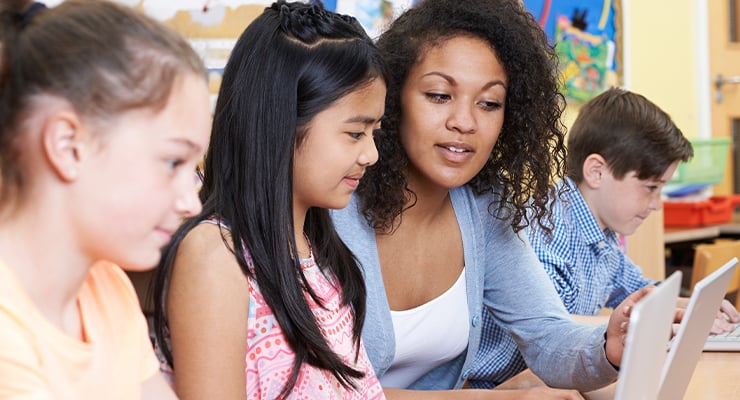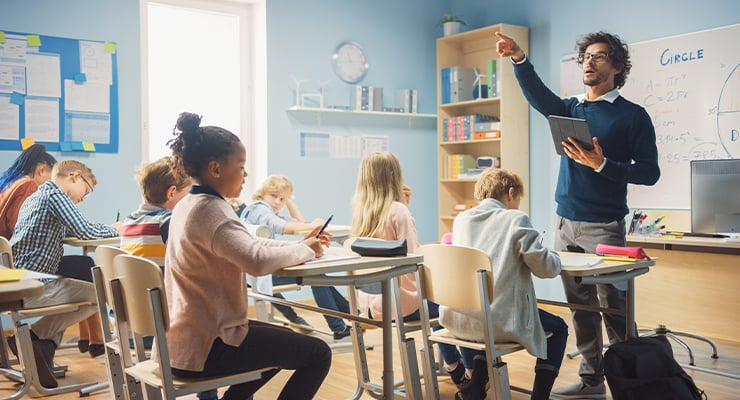 Written by: Barbara Green // May 17, 2022
Written by: Barbara Green // May 17, 2022
Last updated: Jan 17, 2023
The range of reading abilities in a first-grade classroom can run the gamut; some students devour lengthy chapter books with ease, while others struggle to decode consonant-vowel-consonant words. For this reason, teachers have long employed differentiated instruction to meet students where they are and keep them engaged.
The pandemic, with its varied student experiences, has only heightened the need for a more tailored approach. Indeed, while distance learning foregrounded edtech in conversations about education, the growing push for more targeted teaching is keeping it there. Read on to find out how edtech tools can help deliver personalized learning experiences.
Using EdTech to Assess What Students Know
Effective teaching often starts with figuring out what students know – and don’t know. While there are various ways to assess, both formal and informal, technology can help make the process easier.
Computer-based assessment tools have gotten sophisticated enough to help push the limits of student achievement, highlighting both strengths and opportunities for improvement. Adaptive testing can help teachers identify students in need of greater challenges and find just where their learners fall compared to peers. When administered multiple times throughout the year, sophisticated progress-monitoring tools allow teachers to track growth, gauge retention of lessons, identify trends, and more concretely evaluate what’s working in the classroom and what isn’t.
Edtech assessment doesn’t have to be comprehensive (or standardized) to be effective, though. Many teachers and districts use tools like FlipGrid, Kahoot! and NearPod for pre- and post-lesson assessment – without the burden of grading by hand. These tools come with other benefits, as well, not the least of which is saving teachers valuable time.

Freeing Up Time with EdTech Tools
As educators increasingly incorporate technology into their teaching, don’t look for teachers to be replaced by apps and computers. Rather, expect those tools to enable teachers to spend more time focusing on what really matters – mentoring, building classroom rapport and motivation, inspiring students, and delivering more personalized learning experiences.
Some sources estimate edtech can save 20-40% of the roughly 50 hours per week the typical teacher works, helping not only avoid teacher burnout but letting educators focus their time more closely on student growth and learning.
In addition to saving teachers time spent grading, edtech can also streamline administrative duties, communication with parents, and even lesson planning. With a wealth of online materials, teachers don’t need to reinvent the wheel when crafting lessons and classroom activities. Tech-based assessments also allow teachers to create data-rich reports with ease, while centralized communication platforms like Class Dojo and Remind enable them to keep in touch with parents much more easily.
One caveat: as edtech shifts what gets measured and how teachers communicate, school leaders will have to diligently protect time saved. More data can introduce more complexity to measurement and tracking, which can make it take longer. Communication, too, is a two-way street; if it’s easier for teachers to reach out to parents, it’s also easier for parents to reach out to teachers. Being vigilant up front will help administrators make sure they aren’t trading one time demand for another.
Using EdTech to Personalize Classwork
As teachers better understand exactly where their students are academically, they can deliver more targeted and personalized instruction. This may be as simple as grouping students by level, using tech to allow students to work through a series of adaptive lessons at their own pace, or curating appropriate reading materials for students to choose from.
Certainly, teachers can achieve some level of personalized learning without technology. However, edtech can make the process more efficient and effective. For example, technology can allow teachers to track progress on individual student goals and how they relate to learning outcomes. It can also allow students to work independently and at their own pace on customized or adaptive materials – with feedback – while teachers lead small-group instruction or work one-on-one with other pupils. Students working at their own pace may not feel the frustration of being left behind – or held back; students with digital access may also be able to continue learning after hours if so inclined.
Personalized learning, however, goes beyond just meeting students where they are in terms of subject mastery. It also takes into account student preferences, work styles, and interests.
Tech tools like the Renzulli Profiler can help educators better understand and record students’ unique learning styles – like whether they prefer to work individually or in groups, or how they like to receive information – and then provide avenues to suit their styles. Other apps allow students more options in how they participate in work – like recording video or audio, submitted a drawing, etc. As teachers provide a greater variety of learning experiences, they may help spur greater engagement and deeper learning, especially among more reluctant learners.

EdTech and Equity
Proponents of edtech believe it can help boost student achievement and bolster equity for the reasons outlined above. Namely, it can help tailor learning experiences to the needs and preferences of the learners, more clearly identify gaps and opportunities in student mastery of material, free up teacher time to strengthen relationships and offer one-on-one targeted assistance, and help students learn outside the classroom through apps and programs they can access at home.
For those gains and benefits to be realized, though, we must first bridge the digital divide between those who have access to computers and high-speed internet and those who do not. The good news is there is growing momentum toward and support for doing so.
While the digital divide has persisted for decades, the pandemic’s shift to online learning exacerbated inequalities – but also highlighted the need for change. States like Virginia and Minnesota, among others, have stepped up efforts in recent years, as have individual counties throughout the country. And the Digital Equity Act from the Bipartisan Infrastructure Law allocates funding to extend high-speed Internet to lower-income neighborhoods and fund Wi-Fi hotspots in schools along with computers for students.
While teachers and school districts across the country have already made massive inroads incorporating edtech into their classroom learning experiences, proponents are hopeful efforts to bridge the digital divide will only enhance edtech’s effectiveness in creating positive change. When used appropriately and effectively, edtech can help personalize and improve students’ learning experiences through adaptive and curated content, free up teachers to focus on what really matters, and increase access to educational tools outside the classroom.
Keep Learning With USF
In partnership with the Florida Center for Instructional Technology, USF offers courses for K-12 teachers designed to help educators thrive in the digital classroom – and employ digital tools to help students grow. USF also offers summer camps for students to prevent summer learning loss in a fun, interactive environment.
Check out our upcoming courses and programs to see how USF can help grow your teaching career. Courses are delivered in a convenient online format to accommodate your busy schedule.


